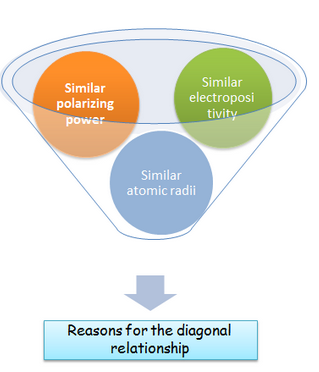The diagonal relationship exists between the certain pairs of diagonally adjacent elements in the second and third periods of the periodic table. These pairs (Be & Al, Li & Mg, B & Si, etc.) exhibits the same properties. For example, silicon and boron, both of them are semiconductors and they have acidic oxides and form the halides which are hydrolyzed in the water. This relationship occurs because the periodic table has opposing effects due to descending and crossing.
On crossing the period of the periodic table, the size of the atom is decreased and on descending the group in periodic- table size of the atoms is increased. Moving along the periods the elements progressively becomes more covalent, more electronegative and less reducing. Whereas on descending the group in the periodic table the elements become more basic, more ionic and less electronegative. So, both crossing and descending a group by one element cancel the changes and elements with similar chemistry and similar properties are often found. Properties of compounds, electronegativity, and atomic size of the diagonal members are similar.

It is a well-known fact that the chemistry of the first group elements is similar to the chemistry of second group elements. So, the chemistry of lithium is similar to the chemistry of magnesium. Chemistry of beryllium is similar to that of aluminum and the chemistry of boron is similar to the chemistry of silicon. This kind of relation is called a diagonal relationship. However, after boron and silicon, it is not noticeable. Still, the reasons for diagonal relationship are not fully understood but it is affected by the charge density. For example, Li+ is small cation and has +1 charge while magnesium has +2 charge and it is somehow larger in size, but roughly charge density on each ion is the same.
The diagonal relationship can be well understood by using the example of the lithium and magnesium pair under the room temperature and pressure.
- Under standard conditions when it is combined with oxygen lithium and magnesium form only the normal oxides while peroxides are formed by the sodium. In addition to that metals below the sodium forms the super-oxides.
- In group I lithium is the only element that forms the stable nitride Li3N. In group II elements magnesium and other elements form the nitrides.
- Lithium carbonate, fluoride, and phosphate are sparingly water-soluble and the corresponding salts of the group II are insoluble.
- Both lithium and magnesium form the covalent organometallic compounds. MgMe2 and LiMe both are valuable synthetic reagents. The other analogues of group I and group II are extremely reactive and ionic thus they are difficult to manipulate.
- Chlorides of both lithium and magnesium are deliquescent, as they absorb the moisture from their surroundings and are soluble in pyridine and alcohol. Like magnesium chloride, lithium chloride is separated from the hydrated crystal LiCl·2H2O.
- The most striking similarity between lithium and magnesium is their capability to form the covalent bonds with the elements of average electronegativity.
